Sometimes vintage copper isn’t stamped by the place that made it but instead with the name of the store that sold it. This page is an ongoing effort to document them.
Here’s a list of the stores I’ve found so far that sold French copper stamped under their own name, in alphabetical order.
- A La Ménagère
- Allez Frères
- A. Simon
- Bazaar de la Cuisine New York
- Bazar Français
- BIA Cordon Bleu
- Blaser & Cie
- BonJour
- The Bridge Company (aka Bridge Kitchenware)
- Charles R. Ruegger (see Bazar Français)
- Chomette Favor
- Cordon Bleu (see BIA Cordon Bleu)
- Crate and Barrel
- Dean & Deluca
- Dehillerin
- The Design Store France
- F. Lejeune (see Lejeune)
- Grands Magasins Du Louvre
- HGR Verbeelen (see Verbeelen)
- Kitchen Bazaar France
- Kitchen Glamor
- Lamalle Kitchenware
- Lejeune
- Matfer
- Michel Lejeune Asnières (see Lejeune)
- Mora et Cie. (see Matfer)
- Saillard
- Simon, A (see A. Simon)
- Sur La Table
- Verbeelen
- Williams-Sonoma
I’ve gathered examples of these stamps below. Some are from my own collection but I’ve also gone on a photo safari of sorts on eBay and Etsy. (If you have a pot with a stamp that’s not listed here, I’d love to include it!)
A La MénagèreThis department store on the ground floor of the magnificent building at 20 Boulevard Bonne-Nouvelle was one of the grandest retail emporia in Paris from its inception in 1863 until it closed in 1930. A La Ménagère copper doesn’t have a store stamp in the conventional sense — that is, there is nothing stamped into the body of the copper. Instead, the store name is stamped onto the upper surface of the iron handle. The store existed as “A La Ménagère” from 1863 to 1899 after which it was known as “Galeries de la Ménagère.” The handles are stamped “A La Ménagère”, which suggests to me that the copper was produced before 1899; after that point, the stamp should have been changed to “De La Ménagère” to match the store’s renaming. Based on this, I propose that a piece of copper carrying the A La Ménagère handle design was produced between 1863 and 1899. |
 This handle style has an arrow-shaped baseplate. The handle is stamped “A La Ménagère A Paris B. Bonne-Nouvelle 20.” This handle style has an arrow-shaped baseplate. The handle is stamped “A La Ménagère A Paris B. Bonne-Nouvelle 20.” |
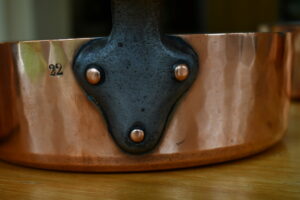 This handle style has a more clover-leaf shaped baseplate. The handle is stamped “A La Ménagère Paris.” This handle style has a more clover-leaf shaped baseplate. The handle is stamped “A La Ménagère Paris.”
|
Allez FrèresThe Allez brothers (and sometimes nephews and sons) operated a hardware and department store in Les Halles in Paris from 1803 into the 1930s. The shop started at Quai de la Mégisserie before moving to 1 Rue Saint-Martin in 1856. This was a great location near the place du Châtelet, the former site of the Grand Châtelet, a castle built in the 12th century by Louis VI and destroyed by Napoleon in 1802 to create the square. (You’ll sometimes see Allez Frères documents with “Au Châtelet” to let people know the store was quite close to this important city landmark.)
I do not know whether Allez Frères made their own copper; from 1883 to 1900 they specified fabrication en Villedieu-les-Poêles, but it seems more likely that they commissioned copper from an existing maker rather than set up their own factory. I suspect that maker was most likely Mauviel-Gautier Frères but would welcome further information on this if you have any. |
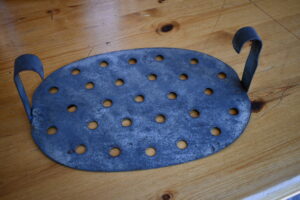 The Allez Frères stamp has the words “Établissements ALLEZ Frères Paris” within an oval cartouche. The Allez Frères stamp has the words “Établissements ALLEZ Frères Paris” within an oval cartouche. |
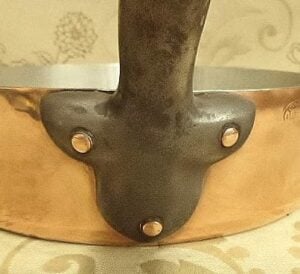 This is the distinctive iron handle baseplate that I have nicknamed the “trefoil” because of its three-leafed shapes. This is the distinctive iron handle baseplate that I have nicknamed the “trefoil” because of its three-leafed shapes.
|
A. Simon
A. Simon is a cookware store in Les Halles, the historic culinary district of Paris. One source claims that the store has been operating since 1884. It is still open today at 48 Rue Montmartre. (They seem to have a web site at simon-a.com but I can’t seem to get it to load.) |
 The stamp is an oval cartouche with the words “a.simon PARIS.” It looks an awful lot like a series of stamp designs used by Mauviel for itself as well as customers like Crate and Barrel, Verbeelen, and Dehillerin. My current guess is that this oval stamp design is from the 1980s. |
Bazaar de la Cuisine New YorkThis kitchen store operated from about 1969 to 1984 with locations at 1003 Second Avenue and 160 East 55th in New York City. As its name suggests, it imported a wide range of French and European kitchenware including copper items. According to the New York Times, its closure in 1984 was due to a 300 percent rent increase. The store used two text stamps. At the moment I believe one stamp appears on cooking utensils while the other was on copper cookware. My guess is that the store sourced these items from two different suppliers and each supplier had its own version of the stamp. |
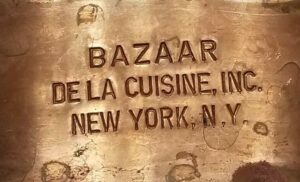
This is the stamp I’ve seen on cooking utensils (bowls, Bains Maries, et cetera). It reads “BAZAAR DE LA CUISINE, INC. NEW YORK, N.Y.” It’s possible that items with this stamp are not French-made but US-made. The items I’ve seen aren’t stamped “Made in France” as one would expect. Furthermore, the porcelain insert on the Bain Marie was Hall (made in the United States) while French Bains Maries would have a French porcelain insert (Pillivuyt, Apilco, or the like). |
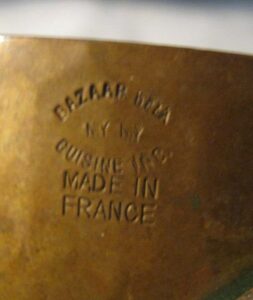 This is the version I’ve seen on a copper saucepan. It reads “BAZAAR DELA CUISINE INC.” in an oval with “N.Y. N.Y.” in the center, with a “MADE IN FRANCE” notation below. This is the version I’ve seen on a copper saucepan. It reads “BAZAAR DELA CUISINE INC.” in an oval with “N.Y. N.Y.” in the center, with a “MADE IN FRANCE” notation below.
I don’t know if this “Made in France” stamp is a standalone stamp or integrated with the store stamp above it. The typography looks quite like the “long-M” stamp used by Mauviel (as well as Gaillard and Jacquotot). I’m always alert to the style of Made in France stamp because it can be a clue as to the maker of a store’s pans; unfortunately, the stamp in question doesn’t really narrow things down. This saucepan example looks like Mauviel to me but I can’t be certain. (Special thanks to reader Cameron for bringing my attention to this pan — I very much appreciate extra eyes looking out for these hard-to-find pieces!) |
Bazar FrançaisCharles R. Ruegger opened his kitchenware store in New York in 1874 on South Fifth Avenue (later renamed West Broadway, now Laguardia Place) near Houston Street, and in 1929 moved it to its famous location at 666 6th Avenue near 22nd Street. In 1930 the company also opened a metalworking shop so that the kitchenware store sold a combination of US-made as well as imported French goods. Charles R. was only able to enjoy the big new store for a year or two — he passed away in 1931. But according to this history, the store stayed firmly in family hands: his son Charles H. Ruegger took over (along with his brother-in-law Victor King), followed by grandson Charles O. Ruegger until 1963 when great-grandson Charles E. Ruegger took the helm. (It was Charles E. who recalled “a young man coming into the store in the late 60’s to buy our copper pans for his newly opened store which was called Crate and Barrel.”) The store closed in 1975 and though it is long gone the building retains a proud facade with CHARLES R. RUEGGER 1929. I’ve seen |
 This is what we believe to be the first Ruegger stamp. It reads “Charles R. Ruegger Inc / New York / Made in France.” (Interestingly, the pot in question is, to all appearances, English — tin band, arrow-shaped handle baseplate. It’s a quandary.) This is what we believe to be the first Ruegger stamp. It reads “Charles R. Ruegger Inc / New York / Made in France.” (Interestingly, the pot in question is, to all appearances, English — tin band, arrow-shaped handle baseplate. It’s a quandary.)
At the moment our theories that this is the first stamp in the series, used from 1874 until 1895. |
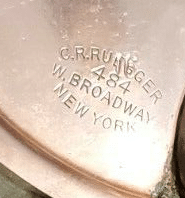 This stamp has four lines of text in an oval shape. Notably, the street address is “484 West Broadway,” an important clue to its timing. According to Wikipedia, this section of South Fifth Avenue was renamed West Broadway in 1895, which sets a start date for the use of this stamp. The particular item with this stamp also has a separate “Made in France” stamp with the same distinctive typeface as the one just above. This stamp has four lines of text in an oval shape. Notably, the street address is “484 West Broadway,” an important clue to its timing. According to Wikipedia, this section of South Fifth Avenue was renamed West Broadway in 1895, which sets a start date for the use of this stamp. The particular item with this stamp also has a separate “Made in France” stamp with the same distinctive typeface as the one just above.
|
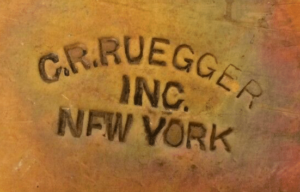 This stamp reads “C.R. RUEGGER / INC / NEW YORK.” This pot also had a separate stamp simply stating “FRANCE.” This stamp reads “C.R. RUEGGER / INC / NEW YORK.” This pot also had a separate stamp simply stating “FRANCE.”
We think this is the third stamp in use from the early 20th century up until 1929, but this is a guess. The 484 W Broadway stamp just above can be conveniently pinned to the 1895 change in the street’s name, but this stamp could have come before it. However, assuming a 10-15 year lifespan for the average copper stamp, it seems more likely that this stamp was used after the 484 W Broadway version, perhaps from the 1910s up to 1929. |
 This is the fourth stamp. With the “666” number, it must have been used after Charles set up the store on at 666 6th Avenue in 1929. This is the fourth stamp. With the “666” number, it must have been used after Charles set up the store on at 666 6th Avenue in 1929.
This is the only example I have seen of this stamp, and it’s on a round gratin pan. The gratin looks like mid-20th century French to me but there is no “Made in France” on it. It could either be a French pan imported prior to 1960 (or so) when the “Made in France” stamp became a requirement for French goods, or it is a French-like pan that Bazar Français made. Charles opened his own small metalworking shop in 1930 and could produce some copper items such as bowls and utensils. |
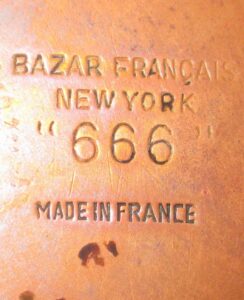 This is the fifth I’ve seen this stamp with and without the “Made in France.” If an item has is no “Made in France,” then it probably came from the Bazar Français workshop. If there is a “Made in France” stamp, it’s likely imported Mauviel. |
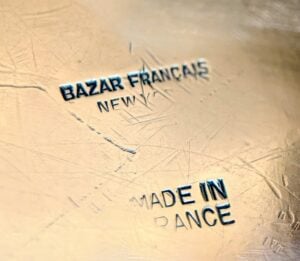 Thanks to reader Donn F., we have a sample of a sixth Bazar Français stamp. It is similar to the fifth version above but omits the 666 street number. Says Donn, “Although the pot was heavily used and has plenty of nicks and scuffs, the area around the stamp isn’t worn enough for the whole bottom line to have been obliterated. And while it seems to be mis-struck favoring the top, I don’t usually find a bottom third of a stamp missing from not being struck true — if it were struck wrong enough to leave the third line off, I don’t think the second line would have imprinted.” I respect his insight here and agree that this is a distinct stamp.Here’s Donn’s theory as to its date. Thanks to reader Donn F., we have a sample of a sixth Bazar Français stamp. It is similar to the fifth version above but omits the 666 street number. Says Donn, “Although the pot was heavily used and has plenty of nicks and scuffs, the area around the stamp isn’t worn enough for the whole bottom line to have been obliterated. And while it seems to be mis-struck favoring the top, I don’t usually find a bottom third of a stamp missing from not being struck true — if it were struck wrong enough to leave the third line off, I don’t think the second line would have imprinted.” I respect his insight here and agree that this is a distinct stamp.Here’s Donn’s theory as to its date.
[This stamp version] of course can’t predate Ruegger moving into the 666 building since it has a Made in France stamp from around 1960 or later. My thought is it could be from the last few years of operation, if the cultural association between 666 and the devil cropped up in the 1970s — I’ve heard it told as the 1976 movie “The Omen” popularized the superstition around the number, but haven’t seen an in-depth article on this, and it could be the movie was playing on a meme that was already percolating around that time. If so, it would have made sense for a cookware store to switch stamps to avoid scaring off devout customers. This sounds reasonable to me. I have seen Bazar Français stamps with the 666 deliberately scratched out, which suggests that the “666” association may have become a liability for the brand. |
BIA Cordon Bleu
Based on this information, I believe that BIA copper was made by Mauviel and imported to the US between 1952 and about 2000. That said, I don’t believe Mauviel was exporting copper in volume in the early 1950s; I think that began later in the 1960s, when the company began supplying Williams-Sonoma and ramped up production. At the moment I suspect that BIA copper is most likely Mauviel from the 1970s to the early 2000s. Take a look at this photo from a 1970s-era catalog displaying a range of French copper pieces — the styling and handles look like Mauviel to my eye. One distinct characteristic to note: The lollipop-style lids appear to have been given all-over hammering. (You can see the distinctly rippled look in the photo above.) I suspect this was a special request from BIA to Mauviel in order to provide a distinctive product to the US customer. I have seen two versions of the copper stamp. Unfortunately I don’t know the chronological order at this time.
|
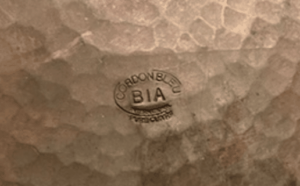 This second version is a visually simpler stamp. The words at the bottom of the stamp are hard to read, but I suspect one word may be “INTERNATIONAL”. This second version is a visually simpler stamp. The words at the bottom of the stamp are hard to read, but I suspect one word may be “INTERNATIONAL”.
(This stamp example is provided from a lid and you can clearly see the hammering.) |
Blaser & Cie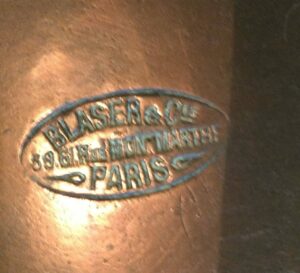 Blaser & Cie (“Compagnie”) was a kitchenware reseller at 59 and 61 Rue Montmartre in Paris from the late 1920s (possibly 1928) to about 1935. TJFRANCE has seen evidence of the company in 1928, but I have not been able to verify this. Founder Alfred Blaser (1874-1973) liquidated the firm “Blaser & Cie” in 1935. TJ again sees the firm in the 1940s as the restaurant supply business Établissements Blaser, which continued until 1973. Based on this admittedly thin information, I believe pieces with the Blaser & Cie stamp were made between 1928 and 1935. Thanks to reader Alan Richardson for providing a clear example of this rare stamp. |
BonJourBonJour was a high-end kitchenware brand launched by Frank Brady, a housewares marketing entrepreneur in the San Francisco Bay Area. (Other brands he has created or helped to launch include All-Clad, Krups, Dansk, Shun, Nespresso, Meyer, Le Creuset, Brita and Microplane.) I don’t know exactly when the brand was invented but it goes back to at least 1991. In 2005 it was purchased by Meyer Corporation and continues to this day as one of several brands under the Meyer umbrella. In its early days, the company seems to have focused on products that made high-end European cooking more accessible to Americans. For example, Frank Brady claims that the company invented and marketed the first milk frother that instantly helped U.S. consumers get more enjoyment from their European espresso makers. I can’t find any records of retail storefronts for the store, so it seems to have been an importer and wholesaler of European and Asian products for U.S. retailers.
I don’t know who BonJour’s retail partners were — Frank Brady said in a recent interview that Chuck Williams was one of them, but of course Williams-Sonoma had its own channel to import Mauviel copper. But of course as with all these store stamps, it matters not where the copper was purchased but instead the inherent quality of its manufacture. And in my experience, BonJour-stamped pieces are well-made Mauviel. |
The Bridge CompanyBridge Kitchenware and its proprietor, Fred Bridge, were a fixture in the New York culinary scene. While the store closed its doors in 2008, Steven Bridge continues to operate an online store. Copper with a Bridge stamp is top quality Mauviel. |
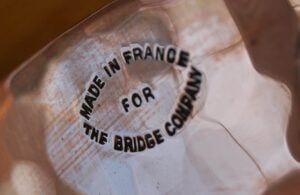
The Bridge stamp is understated — just the text. According to the company’s history, the firm was called “The Bridge Company” until the 1970s when it changed to “Bridge Kitchenware Corp,” so it’s possible this stamp is from the 1970s prior to the change. |
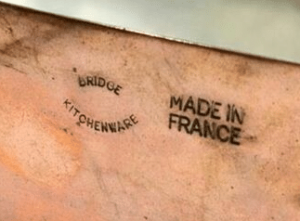 This version of the stamp reads “Bridge Kitchenware” and carries a separate “Made in France” stamp. The wording suggests that this version was used after the store’s name change in the 1970s. This version of the stamp reads “Bridge Kitchenware” and carries a separate “Made in France” stamp. The wording suggests that this version was used after the store’s name change in the 1970s.
(Note the Made in France stamp style. This photo is cropped and it makes the Made in France look bigger than it is, but this is the “Short M narrow” version that correlates with Mauviel.) Thanks to reader Bryan P. for bringing this example to my attention! |
|
|
Crate and BarrelThis well-known furniture and home goods store was founded in Chicago in 1962 “after a European honeymoon sparked the idea to bring simple, beautiful and practical housewares to the US market.” This mission included importing Mauviel copper cookware for a period of time. I don’t know for exactly how long, but looking at the styling of the Mauviel-made pieces, I suspect it was into the late 1990s or the early 2000s at the latest, before Mauviel re-launched its own branding. |
|
Unfortunately I don’t have enough information yet to speculate as to how long the company used this stamp before transitioning to the second version below. |
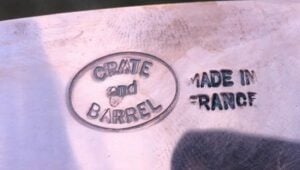
This is a more prevalent mark and I believe it is the store’s second stamp. It is a simple oval cartouche along with the Mauviel version of MADE IN FRANCE. As above, I believe this was the store stamp used for the majority of Mauviel-made copper sold by Crate and Barrel up into the late 1990s or early 2000s. (Again, I add the caveat that this is based on my observation of the styling of the pieces — I welcome more information on this!) |
Chomette FavorThe modern-day Chomette is a restaurant supply store in France, but there was an early kitchenware store founded by Marius François Chomette (1867-1946) at 13 Rue de Halles in Paris. The first listing I can find for this store in Paris is in 1896, listed as a savonnerie des Châtelliers (soap-maker for castellans). By 1914 the store provided fournitures spéciales pour grands hotels et restaurants (special products for large hotels and restaurants) and had expanded to occupy 11bis & 13 Rue de Renard.By 1921 Marius seems to have retired and the store had become Chomette & Huette. Sometime between 1923 and 1925 the store moved to 21 Rue de Renard in the 4th arrondissement, and in 1927 merged with the Favor paper company to form Établissements Chomette-Favor. I believe the company operated a retail storefront for some time, perhaps even into the 1990s, before transforming into a primarily online and catalog-driven restaurant and catering supply and service group. |
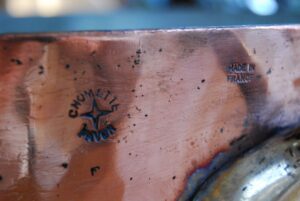
The Chomette Favor stamp is a compass rose. As the “Made in France” declaration is not worked into the logo, there will be a separate MADE IN FRANCE stamp. I don’t believe Chomette ever made copper, and I suspect they instead sold Mauviel. |
Dean & DeLuca
Based on the lovely example shown at right, provided by reader Charles R., it appears that Dean & DeLuca also imported French copper for a period of time. The stamp is a simple oval cartouche reading “DEAN & DELUCA NEW YORK”. Charles suggests that this is Mauviel, and judging by the accompanying “MADE IN FRANCE” stamp, the look of the handle and rivets, and the timing of Dean & DeLuca’s heyday in the 1990s, I agree! |
DehillerinThis famous cookware store in Paris manufactured its own copper until World War II. After that, it placed a series of Dehillerin stamps on copper made by others — most commonly Mauviel. Please see my field guide to Dehillerin to see what I’ve learned about this store’s history and copper production. |
The Design Store France
The store stamp is very simple — three lines of text, “The Design Store France,” with a separate “MADE IN FRANCE” stamp. |
Grands Magasins Du LouvreThis beautiful department store in Paris commissioned a line of gorgeous copper cookware from Mauviel during the 1880s to early 1920s. Please see this fantastic guest post from Tom Larham, “Mauviel’s Masterpieces: Copper at the Grands Magasins Du Louvre, Paris” for history and photos of these pans. |
Kitchen Bazaar FranceThere are two possibilities for this: the French chain, or the US chain. The French chain opened in 2000 or so and has stores in the Paris area. In the US, the first Kitchen Bazaar store opened in the Washington DC area in 1964 and expanded to 14 stores. It competed with, and was ultimately felled by, Williams-Sonoma and Crate & Barrel, entering bankruptcy in 1992 and finally closing its doors in 1996. |
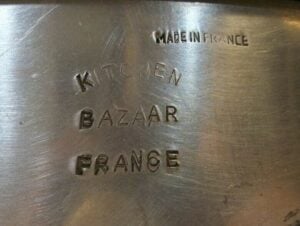
This stamp is a simple text treatment with “Kitchen Bazaar France” alongside “Made in France.” I don’t think this is Mauviel — the stamp and handle designs are not consistent. I don’t know at this moment who made this copper but will update when I find out. |
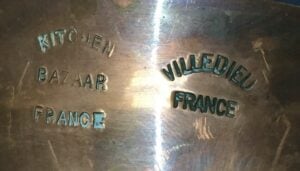 The store stamp is the same but the second “Villedieu France” stamp is a different design — my guess is that pot is from a different manufacturer. The store stamp is the same but the second “Villedieu France” stamp is a different design — my guess is that pot is from a different manufacturer.
|
Kitchen Glamor
Kitchen Glamor was founded by Syd and Gilda Krause in 1950 on Fenkell Avenue in Detroit. It moved to Redford in 1970. Christopher Patsalis went to work for them in 1972, and [his wife] Toula followed to work as a secretary. … They bought the business in 1975 … Kitchen Glamor opened its second store in Great Oaks Mall in Rochester in 1978. It followed with a third store in 1980 in the original Somerset Mall. That store was later moved to West Bloomfield Township. The fourth store opened in Novi Town Center five years later in 1991.” The store imported French copper along with other high-end kitchenware. The store chain closed in 2000 but hung on at least until 2008 as a store-within-a-store at Hawthorne Appliance in Birmingham. The store stamp is a simple oval text logo, “Kitchen Glamor Inc. / Detroit / Made in France.” According to TJFRANCE they imported copper from CVD, a line of tin-lined copper made by GAOR in Villedieu. |
Lamalle KitchenwareCharles F. Lamalle, the son of charcutiers in Lons-le-Saunier, came to New York City in 1927 when he was 22 and opened a kitchenware store. He imported Mauviel copper, Sabatier knives, and other French kitchenware goods long before other gourmet kitchen stores opened in the 1960s. The store had two locations over time: the sixth floor of a warehouse on 25th street (variously reported as 36 West 25th Street or 1123 Broadway) and a showroom on the third floor of 225 Fifth Avenue.Mr. Lamalle was a colorful and beloved character. In a charming profile from 1983 of the man and his store, The New York Times said “Mr. Lamalle … is to French copperware what Tiffany & Company is to diamonds” and “[his] specialty is triple-gauge copper pots and skillets with thick bronze handles, some of which weigh as much as a young St. Bernard. Ed Levine wrote in 1997 that “Coming upon [his store] in this neighborhood is like discovering Williams Sonoma had a nutty, eccentric older sister.” He was the inspiration for “Charly Poisson,” the fictional chef detective in his daughter Cecile’s series of culinary mystery books. The store closed sometime between 1989 and 1991 (sources differ), and Lamalle passed away in March 1992. Chip Fisher bought the store in 1993 (after having tried and failed to buy Bridge Kitchenware after Fred Bridge’s death). Gourmet Retailer wrote in 1994, “After Lamalle died, an attempt was made to transform the shop into a retail outlet but alas, Monsieur Lamalle was the heart and soul of the place and truly represented another, more graceful era.” I can’t find confirmation of exactly when the store closed, but there was a deep sale in June 1997 in preparation for moving to a new location for which, ominously, a lease had not been signed. |
 The Lamalle store stamp is a simple text stamp, “LAMALLE N.Y. CITY.” The store was known for importing Mauviel, so chances are that a Lamalle pot will be a high-quality piece. |
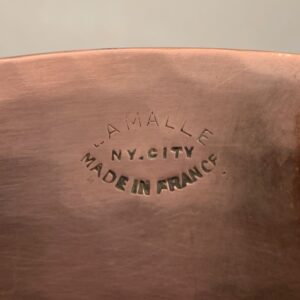 Here is a second version, with text in an oval shape reading “LAMALLE N.Y. CITY MADE IN FRANCE.” Here is a second version, with text in an oval shape reading “LAMALLE N.Y. CITY MADE IN FRANCE.”
This photo was helpfully provided by reader Ron P. |
 This version of the stamp is three lines reading “LAMALLE NEW-YORK CITY MADE IN FRANCE.” Reader Bryan P. brought this to my attention. I don’t know if it’s newer or older than the versions above. |
LejeuneThis is a kitchenware store outside Paris that operated from 1930 to 1973 in downtown Paris as F. Lejeune, and then from 1973 to the present in Asnières as Établissments Michel Lejeune. In 1930, Francis Lejeune opened a store at 76 rue Vaneau in the 7th arrondissement of Paris to retin the copper cookware of the restaurants and hotels. (This was also the location of the former Saillard.) The business grew into a kitchenware supply store that also sold copper. In 1973, Michel and Christiane Lejeune moved the firm to Asnières outside of Paris. The firm continues to supply kitchenware to the professional catering and patisserie industry. As far as I can tell, the company did not make copper cookware, but rather resold copper (I suspect Mauviel) under a Lejeune store stamp. I have seen two Lejeune stamps that can help with establishing the date estimate for a specific piece. (My thanks to reader Chris N. for helping to find this history.) |
F. Lejeune Paris
|
Lejeune Paris
This version reminds me of a Dehillerin stamp from what may be the same era. I wonder whether Mauviel (who supplied both houses) made similar stamps for these different retailers. |
Michel Lejeune Asnières
|
MatferThe Matfer-Bourgeat of today is the modern incarnation of a series of kitchenware stores (including Mora et Cie.) that claims lineage back to Paris in 1814. I’ve put together a field guide to Matfer that places all these stamps in historical context, but to keep things brief: Matfer did not make copper pots and pans but put its store mark on quality copper from Mauviel and L. Lecellier. |
SaillardSaillard is one of the lesser-known Parisian makers — I’ve only seen a few of their marked pieces — and they seem to have been in business in the 1920s. The earliest business listing that I am certain represents this company appears in 1922: “Saillard, étameur, Rue de Saint-Simon 8.” In 1925, “Saillard, étameur” is listed at 76 Rue Vaneau (sometimes rendered Vanneau). “Saillard Père et Fils” composed of Joseph Eugène Saillard and Pierre Paul Saillard, both living at 76 Rue Vaneau, was dissolved in 1940. What is curious is that there appears to be some overlap with Lejeune — that is, the retinning (and eventual retail) business that Francis Lejeune operated at the very same address. The Lejeune company history claims that Francis opened his store at 76 Rue Vaneau in 1930, but the Saillard business (and two Saillards!) continued also at the same location until 1940. Perhaps Francis began working for Saillard in 1930 and gradually took over the business, perhaps retroactively claiming that it had been under his leadership since 1930? |
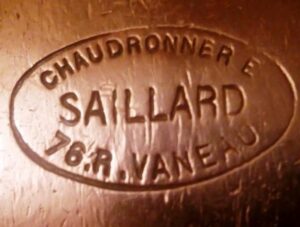 The Saillard stamp is an oval cartouche reading “Chaudonnerie SAILLARD 76 R. VANEAU.” The Saillard stamp is an oval cartouche reading “Chaudonnerie SAILLARD 76 R. VANEAU.”
|
Sur La TableSur La Table is a kitchenware store in the US that started business in Seattle, Washington, in 1972. Its founder, Shirley Collins, sold the company in 1995 to the Behnke family, who opened a second store in Berkeley, California. The company was sold in 2011 to Investcorp, a Bahrain-based investment company.They imported French copper that looks like Mauviel to my eye. |
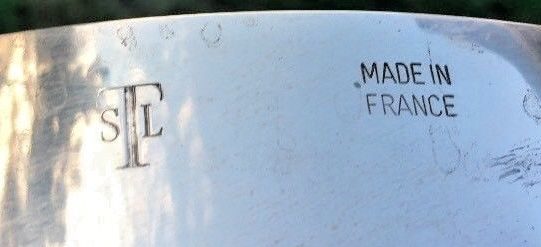
One version of their stamp features the store’s initials, “SLT,” with a separate MADE IN FRANCE stamp. This is an early company logo and points to copper from the 1970s until they changed their logo design. |
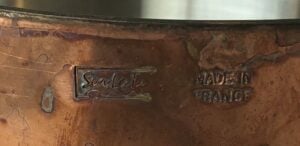
This version of the stamp has “Sur La Table” rendered in script in the same font as the company’s logo. I don’t know when the company changed logo designs, but I suspect it may have been around 1995 when the company changed hands and opened a second location. This is just a guess, however! |
Verbeelen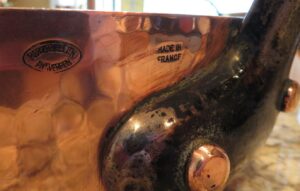 This is a restaurant and hotel supply wholesaler in Antwerp, Belgium, founded in 1947 by Henri Verbeelen. The company continues to operate to this day. The stamp is an oval cartouche with the words “HGRVERBEELEN ANTWERPEN.” The design is very similar to one of Mauviel’s own oval cartouche stamp and those it used on its pieces stamped for Crate and Barrel and Dehillerin, leading me to suspect strongly that Verbeelen also sourced copper from Mauviel. (This is also the Made in France stamp associated with Mauviel.) |
Williams SonomaThe majority of Mauviel copper pots and pans imported to the U.S. starting in the 1960s were sold by Williams-Sonoma. The stamp is a simple text logo, “Williams Sonoma France.” There are two versions that have a subtle typography difference — I don’t yet know what the significance is between them. |
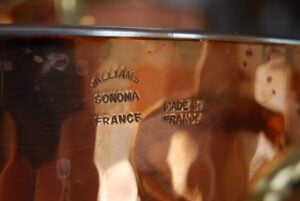
This version is slightly more spaced out than the other. |
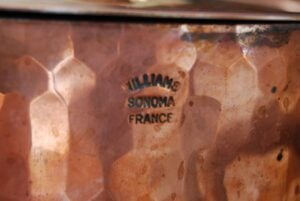
In this version, the letters are more closely spaced. |
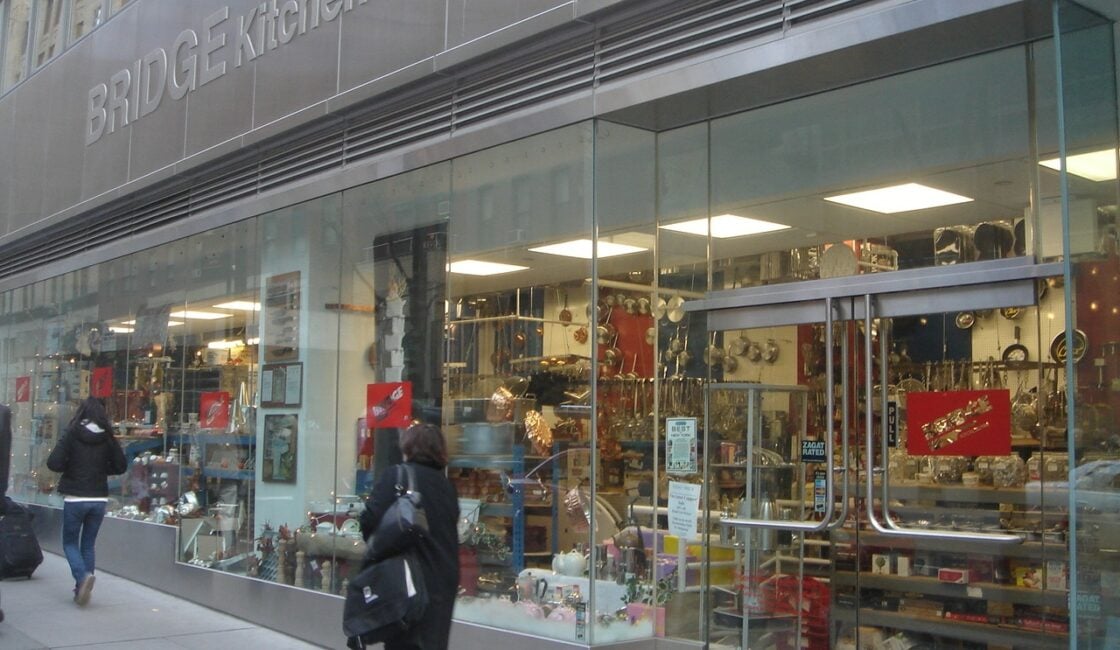
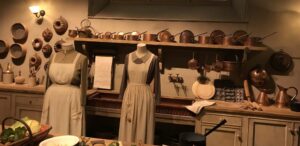 The store furnished the great hotels and houses of Europe with everything from bathtubs to garden furniture and, yes, beautiful copper. Their iron-handled pans can be easily recognized by the trefoil base. The photo on the right is from the traveling “Downton Abbey” exhibition in Boston in July 2019, and if you look closely at the saucepans on the shelf over the stove you will see some of them appear to be Allez Frères pans, which would be correct for the timing of the television show. (The other saucepans look French as well, and could be Gaillard or Dehillerin.)
The store furnished the great hotels and houses of Europe with everything from bathtubs to garden furniture and, yes, beautiful copper. Their iron-handled pans can be easily recognized by the trefoil base. The photo on the right is from the traveling “Downton Abbey” exhibition in Boston in July 2019, and if you look closely at the saucepans on the shelf over the stove you will see some of them appear to be Allez Frères pans, which would be correct for the timing of the television show. (The other saucepans look French as well, and could be Gaillard or Dehillerin.)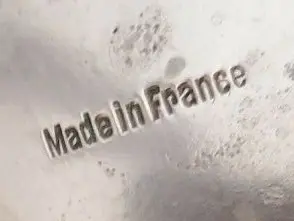 Based on this, Bryan and I think that this is the second of the four stamps we’ve uncovered, in use from 1895 and into the early 20th century.
Based on this, Bryan and I think that this is the second of the four stamps we’ve uncovered, in use from 1895 and into the early 20th century.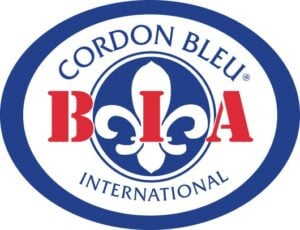
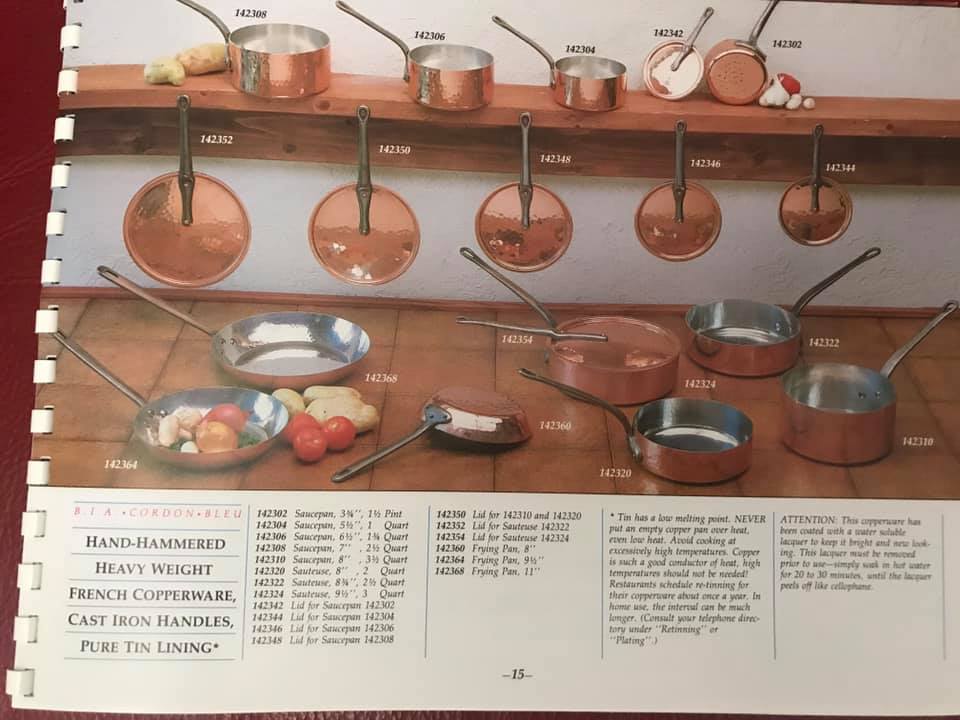
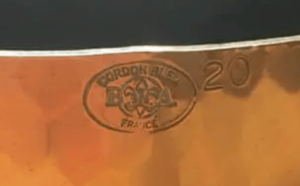
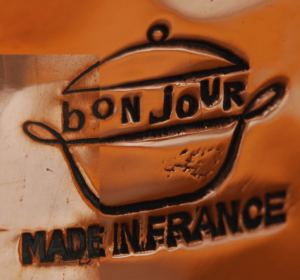 Part of this effort was to import French copper that, to my eye, is clearly Mauviel make. The BonJour stamp is a stylized cockpit bubbling over with the word “bonjour” over the ever-important Made in France statement. This image looks a little janky because I built it by combining photos of stamps from two of my pots. Each stamp was a little messed up but I combined them into one image. I have yet to see an example of a BonJour stamp that is clean and complete!
Part of this effort was to import French copper that, to my eye, is clearly Mauviel make. The BonJour stamp is a stylized cockpit bubbling over with the word “bonjour” over the ever-important Made in France statement. This image looks a little janky because I built it by combining photos of stamps from two of my pots. Each stamp was a little messed up but I combined them into one image. I have yet to see an example of a BonJour stamp that is clean and complete!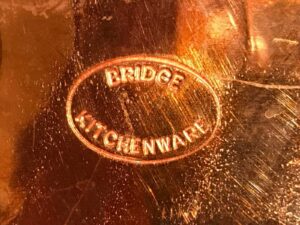 And here’s a third version of the stamp — an oval cartouche reading “Bridge Kitchenware.” The wording is post-1970s name change and the style is different from the two above, which leads me to suspect it’s the latest of the three.
And here’s a third version of the stamp — an oval cartouche reading “Bridge Kitchenware.” The wording is post-1970s name change and the style is different from the two above, which leads me to suspect it’s the latest of the three.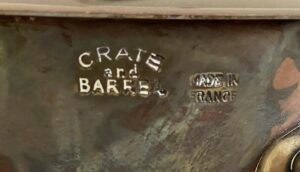 This is a very rare stamp that hawk-eyed reader Al G. brought to my attention — it is the only one of its kind that I have seen. I suspect this is the first version of the Crate and Barrel store stamp. The MADE IN FRANCE looks to me to be the rounded Mauviel version.
This is a very rare stamp that hawk-eyed reader Al G. brought to my attention — it is the only one of its kind that I have seen. I suspect this is the first version of the Crate and Barrel store stamp. The MADE IN FRANCE looks to me to be the rounded Mauviel version.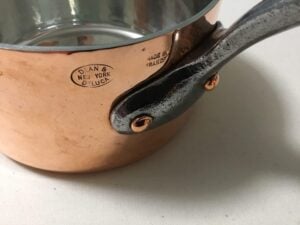
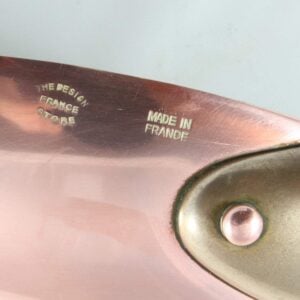 I don’t know much about this store, but I know they sold quality copper, including by Mauviel. I gave my aunt two 3mm thick, hammered-finish saucepans with this stamp that are as gorgeous as anything. I wish I knew more about this store — I can’t find anything about it online, and I fear it went out of business prior to the Internet, so there’s not much available. If you know anything I’d love to learn and add information here.
I don’t know much about this store, but I know they sold quality copper, including by Mauviel. I gave my aunt two 3mm thick, hammered-finish saucepans with this stamp that are as gorgeous as anything. I wish I knew more about this store — I can’t find anything about it online, and I fear it went out of business prior to the Internet, so there’s not much available. If you know anything I’d love to learn and add information here.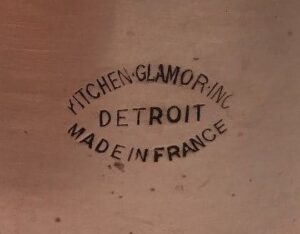 I can’t improve upon this concise history from an article in
I can’t improve upon this concise history from an article in 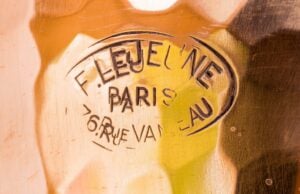 This is an oval cartouche reading “F. LEJEUNE 76. RUE VANEAU PARIS.” I believe it corresponds to copper produced while the company was still in downtown Paris, prior to 1973.
This is an oval cartouche reading “F. LEJEUNE 76. RUE VANEAU PARIS.” I believe it corresponds to copper produced while the company was still in downtown Paris, prior to 1973.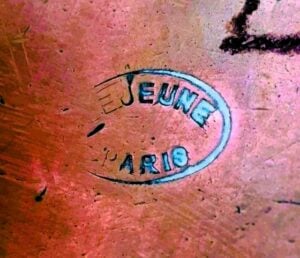 Martin located another version of this stamp. It is similar to the one above, but simpler, without the Rue Vaneau address.
Martin located another version of this stamp. It is similar to the one above, but simpler, without the Rue Vaneau address.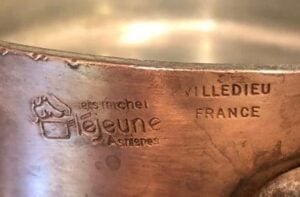
Hello, this stamp from the Lamalle kitchenware store in New York City is on a 28cm tin-lined copper saute I bought on ebay. I am listing 3 links to my photobucket album as i am not sure which, if any, will work. I have been using copper cookware for 20 years but it wasn’t until I started looking at postings on Chowhound and on your very interesting blog that I took an interest in collecting pieces for display. The only “large size” piece I had in my original set of copper pans is a 32cm stewpan I purchased online from Dehillerin which I recently had re-tinned by East Coast Tinning.
Regards,
Steve Whalen
(Steve, I messed around a bit to figure out how to get the photos to show up inline, and ended up bringing them over — Photobucket was being fussy. I kept your original links below. -VFC)
—-
[IMG]https://oi1053.photobucket.com/albums/s471/swhalen10/Copper%20WS%2011.5-6_zpszkpawxlx.jpg[/IMG]
https://s1053.photobucket.com/user/swhalen10/media/Copper%20WS%2011.5-6_zpszkpawxlx.jpg.html
https://oi1053.photobucket.com/albums/s471/swhalen10/Copper%20WS%2011.5-6_zpszkpawxlx.jpg
[IMG]https://oi1053.photobucket.com/albums/s471/swhalen10/001_zpsv7pgb7h7.jpg[/IMG]
https://s1053.photobucket.com/user/swhalen10/media/001_zpsv7pgb7h7.jpg.html
https://oi1053.photobucket.com/albums/s471/swhalen10/001_zpsv7pgb7h7.jpg
[IMG]https://oi1053.photobucket.com/albums/s471/swhalen10/003_zpsjri8saaa.jpg[/IMG]
https://s1053.photobucket.com/user/swhalen10/media/003_zpsjri8saaa.jpg.html
https://oi1053.photobucket.com/albums/s471/swhalen10/003_zpsjri8saaa.jpg
Thank you Steve! Would you allow me to update the post with this information and one of your photos as an example?
Yes, no problem.
Steve
Here’s a paragraph written in Gourmet Retailer in 1994 about the most influential people in the culinary industry.
“Long before there was Sur La Table or Dean & DeLuca or even Williams-Sonoma, there was a small, beret-wearing Frenchman who was selling French copper cookware, tools, and bakeware to the greatest chefs in New York and to anyone who came into his shop. Charles Lamalle was an elegant man who had a very nondescript shop upstairs in a warehouse building on Broadway. You walked in to face a counter and whatever you wanted was fetched by a sales assistant from the labyrinth of dusty wooden shelves in the back. He was the first to import Mauviel copper, black steel pans and tart forms, Sabatier cutlery, and Opinel knives. He sold to many of the most prominent kitchenware retailers until they began to import on their own. After Lamalle died, an attempt was made to transform the shop into a retail outlet but alas, Monsieur Lamalle was the heart and soul of the place and truly represented another, more graceful era.”
Oh he sounds delightful! And what a great description — I can just picture him and his shop. It was a little bittersweet to research this post because I learned about all these people who are gone now. Thanks for such an evocative comment!
Hello VFC! Here is a stamp on a 32cm saute pan I own with a stamp “HERVERBEELEN, ANTWERPEN” which is a kitchenware store located in Antwerp, Belgium. The company was started by Henri Verbeelen in 1947 and still offers supplys to the hotel industry.
https://s1053.photobucket.com/user/swhalen10/media/013%20use_zpsyg9gm1di.jpg.html
Thank you! I am adding Verbeelen now!
Here is a stamp on a 36cm stew pan I own from a.simon which is a shop located in Paris. From what I could find out the store was founded in the late 1800’s and still exists today.
https://s1053.photobucket.com/user/swhalen10/media/034_zpsspbit5qn.jpg.html
Thank you! Added! Wish I could find out more about this store. They seem fairly old-school — no website of their own at all.
Hello VFC
Have a look here.
http://www.foodavenue.fr/adresse/a-simon-48-52-rue-montmartre-75002-paris.html
and
http://www.simon-a.com/
I hope this helps.
Best
Fid
Thanks Fidelma! For some reason I can’t get the website to load, though I can see that it exists. I’ve added the URL to the store’s listing above. Thank you!
No problem VFC, I will keep an eye on your new website, it’s a great read and very informative!
Hi VFC, I have a very interesting stamp from Blaser which was a shop in Paris. The stamp is located on the cover of an awesome 40cm Jacquotot saute pan with its matching lid that I purchased. I was curious about the stamp so I e-mailed the very knowledgeable TJ France to see if he could shed some light on it. TJ France kindly replied:
“Regarding your pot Jacquotot, it’s amazing that the two stamps are mixed.
Jacquotot was a reseller manufacturer.
While Blaser was most certainly only a reseller.
So there would have been no problem having the 2 stamps separated on this pot. It does not matter.
Blaser was a kitchen equipment supplier who was at 59 and 61 rue de Montmartre in Paris.
From the 1920s to the early 1970s, Blaser provided equipment for canteens, hotels, schools, restaurants, etc.
There is very little information about them and it is quite rare to find material with their stamping.”
https://s1053.photobucket.com/user/swhalen10/media/Copper%20Jacquotot%20Saute%2040cm-8_zpszad8ftuf.jpg.html
Thank you Stephen! I’ve added it. Looks like quite a rare stamp indeed — and that 40cm Jacquotot must be a beauty!
I actually have a question for you. I have numerous pieces from William Sonoma (handed down) but they are SO tarnished. Any suggestions on what the best product is to bring back its beautiful copper color.
I use Wright’s Copper Cream with great success. Widely available.
Good luck.
Hey Cathy! My favorite tarnish remover is Bistro, but it’s more expensive than other brands and I have to order it online. As Jesse suggests, Wright’s Copper Cream is usually much easier to find — I’ve seen it in grocery stores. You can also try the home remedy of salt, lemon, and ketchup, though it’s not as effective against well-established tarnish. I have other suggestions in the “Cleaning vintage copper” section of my Advice page: https://www.vintagefrenchcopper.com/advice/
I’m sure you’ll be thrilled with your W-S pieces when you get them cleaned up!
This is what we do. Firstly, we give them a good clean in soapy water and remove all burnt on residue, a good soak overnight in a mild detergent is good for stubborn marks (never use an abrasive, salt or lemon) then vigoously polish with a copper cleaner bought from a hardware store. A good tip is to take off the copper cleaner when it is still slightly damp then buff to a shine – it requires much less elbow grease and you get much less residue in the creases. When you have used them in an everyday setting, wash in soapy water and then buff again with a clean, dry tea towel.There are many ways of keeping your pans like you want them to be – some don’t polish at all as they like a copper penny colour, others want the French Hotel Kitchen look, a high shine and not a mark on them – we polish our pans a few times a year and love the look when they are just done but not the hard work!
Excellent advice as always, Fidelma! Thank you!
Hi all,
I recently inherited a set of copper sauce pans from my mother. She picked them up when she was living in Nice France during the late 50 early 60s. I am having a hard time finding anything on the maker. there is a double sail stamp on each and it reads Renaud & J. Clermont Geneve. Does anyone have any info on this maker or suggestions where to learn more?
Thanks!
Hey Sara! I took a look around and I believe Renaud & J. Clermont specialized in silver plate (and they did beautiful work!). It’s possible they did silver-plating work for the French makers and also offered a few of the same pieces under their own name. Could your mother’s pieces be silver-lined? If you’d like to email me some photos I can take a look — my email is vfc at vintagefrenchcopper dot com. Thank you!
Sara,
Do you have a picture of the stamp that you can share?
Change of ownership at SIMON:
The A. Simon Paris business was taken over by G. Detou, a neighboring specialty shop for culinary groceries (a small department specializes in Opinel knives), and has since officially been named G. Detou / A. Simon, 48 & 52 rue Montmartre, 75002 PARIS. Since Google continues to show a store for kitchenware called A. Simon, obviously not all company signs have been replaced, which is quite common practice.
https://www.procedurecollective.fr/fr/liquidation-judiciaire/835124/a-simon-s-a.aspx
https://www.opinel.com/en/store/g-detou/simon
https://www.yelp.com/biz/a-simon-paris
We have 1 lid and 2 pans marked A. Perennez and then the mark for Villedeau. We haven’t found anything on Perennez, figure they must have been a seller at one point? Appreciate all the work you’ve put in, this is a very informative site and hoping you can shed some light on this mark.
Thank- you
Amy and Rosalie Hamilton
Hey Amy and Rosalie! You’re right — Aime Francois Marie Perennez had a store in Villedieu at 14 rue du General de Gaulle from about 1957 to 1989. I don’t know much about it unfortunately, but I did see some postcards on auction sites with a photo of the front window. It looks like it was a great village copper store just jam-packed with pieces. At the moment that property is a restaurant and hotel.
I recently got a copper soup pot stamped Dean and Deluca made in France. The woman told me she got it for an anniversary gift 25 years ago. Would love to attach a photo
Hey Colleen! I’ll send you an email and you can send photos to me if you like. Thanks!
I was looking for a place that would be able to stamp a new Mauviel whisking bowl when I stumbled upon your site. I work at Williams Sonoma and get asked this question occasionally. Do you know of any companies in the U.S. that do this? I’ve found a lot of engraving companies, but am coming up short on companies that have a lot of experience stamping copper. Thank you!
Hey Barbie! I would reach out to one of the current makers of copper cookware — Brooklyn Copper Cookware, Duparquet, or House Copper, for example — and ask them for some guidance.
I have lamalle stamp got it at Goodwill for 4$ today, how do I add pictures
Hey Christopher! The Contact Me page has a way for you to send me a message and photos: https://www.vintagefrenchcopper.com/about/contact-me/
Hello, I just received a pair of sauté pans (30 and 22cm) from an auction I won, and i cannot find the stamp they have anywhere, I was wondering if it might ring a bell with you? The stamp is circular text reading Villedieu Made in France with a single bubble letter “G” in the center. I haven’t been able to find anything close to resembling it. Happy to send pictures.
As for the pans themselves, they’re 2mm thick with either stainless or Nickel lining (I’m not experienced enough to say for sure without testing), and one has a typical brass handle while the larger one has a darker, more robust Iron looking handle. They both seem to have stainless rivets. Thank you, and for relative newbie who wants the pans for cooking but will undoubtedly become a collector, your site is an absolutely immense wealth of knowledge. It’s wonderful.
Hey Matt! What you’re describing is a new stamp for me, but I do know of three Villedieu makers/shops starting with “G” — GAOR, Garnier, and Guillaumet. It’s possible that this is an undiscovered stamp for one of them. All three were in operation during the 1970s-1980s when nickel and stainless were both in production, so they are all candidates. Take a look at “The smiths and shops of Villedieu” page and see if any of the stamps look similar:
https://www.vintagefrenchcopper.com/identification/stamps/modern-copper-in-villedieu/
Hello, YG, Yves Gaultier have a lot of stamps that only show the G with the Y very faint. I will send you the photo that I have, it may help?
Yes I have already scoured the G shops and smiths of villedieu pages. Nothing has looked remotely close to this yet. Someone on Reddit suggested Havard and some other shops referred to Garanti in their stamps for a time, and some of those are the closest in aesthetic I’ve found. The YG is an interesting lead I haven’t heard of before I’ll look into that.
I know it’s a bit of a long shot, but I just picked up a few copper pots from online marked “Chelsea Cookware”. Pretty sure it’s a store stamp, with each of the pans being slightly different. I can’t find a single thing about them online. One definitely looks like it’s mauviel but two others I can’t place.
Hi
I have i my 2 copper pots both having QR stamped on them and one pot having AGBC ,this also has a tap to the lower side of the pot.
the one with a tap measures 14 1/2 ins dia. x 12 ins tall the other is 12 ins dia. and 12ins tall.
Just wondering if you might be able to help identify these please.
Regards
Colin Sutton. 07484777746
Store A. Simon Paris
After a change of ownership, the store is now called G. Detou / A. Simon, 48 & 52 rue Montmartre, 75002 PARIS.
So far I saw only pans of this store, whose production was to be assumed after 1970 and reminded me strongly of Mauviel. But now for the first time I found a Windsor sauté pan 22x8cm 2,8mm 2,55kg with well preserved hammer pattern, equipped with rivets as often seen on pans from the period (roughly) 1900-40. So machine made and hammered in by hand, relatively wide and flat hammered on the outside and inside. The stamp on my Windsor looks the same as on the modern variants: “a. simon PARIS” inserted in an oval (see photo by Stephen Whalen).
Since the house of A. Simon was founded as early as 1884, it was to be assumed that at some point a pan of older date could be found. It is also not too unusual that the stamp remained unchanged for decades. We know the same from Mora Paris and (if I remember correctly) from Michel Lyon.
It is possible that my Windsor was made between 1920 and 1940. Who made this pan for A. Simon, however, remains a mystery to me. I would be interested to know if other readers have also found pans from this store whose manufacture can be dated before 1960 or, better, before 1940.
I have a large (8 qt) stock pot. Not tall more squat. The stamp is like a tall pot with the word “France”. It’s hammered and very heavy. Any idea of the maker?
Hi Dan, without a photo of the stamp, it is almost impossible to advise on such requests. For this purpose, there is the contact address on the page.
I am only a reader, but I have a guess. Could the image be a chef’s hat? Compare your stamp with the one from Matfer.